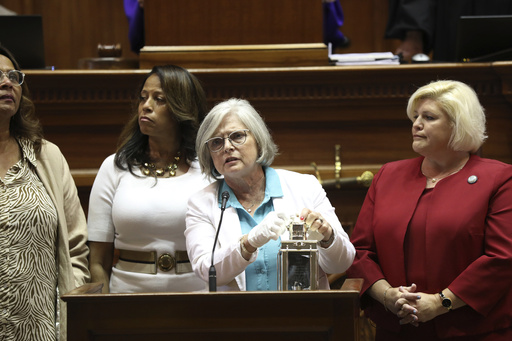
Women are set to achieve a historic milestone in 2025, as they will constitute a majority of state legislators in Colorado and New Mexico for the first time ever. However, the broader landscape reveals that at least 13 states have experienced a decline in female representation following the November elections, as reported by the Rutgers Center for American Women and Politics.
Even with these individual successes, the overall increase in female representation across state legislatures is modest, with women filling just over a third of all legislative seats. Some electoral results are still pending finalization. Kelly Dittmar, the research director at the Center, expressed hope for quicker advancements towards gender parity, emphasizing the need for each election cycle to bring about more substantial increases in female lawmakers in order to normalize gender equality in state legislatures.
As of the latest counts, 2,451 women will occupy seats in state legislatures, which corresponds to 33.2% of the total positions in the country. This figure slightly surpasses the previous record of 2,431 women set in 2024. Notably, the number of Republican women in state legislatures has climbed to at least 852, surpassing the previous high of 815 recorded in 2024. Despite this growth, Debbie Walsh, the director of the Center, noted that Republican women still face significant underrepresentation compared to their Democratic counterparts.
The recent tally indicates that 19 states will witness an uptick in female legislators, with New Mexico and Colorado being the most prominent examples that will achieve a female majority. In New Mexico, voters elected 11 more women to the legislative chambers, while Colorado, having previously achieved gender parity in 2023, will now move to a slight majority of women legislators.
These states follow Nevada, the first in the nation to attain female majority status in its legislature following the 2018 elections. By next year, women will represent nearly 62% of lawmakers in Nevada, significantly surpassing gender parity. Additional notable advancements include women achieving majority status in California’s Senate for the first time in 2025 and significant gains in South Dakota, which saw an increase of at least nine female legislators.
On the other hand, at least 13 states have experienced a decrease in female representation post-election, most severely impacting South Carolina. Earlier in the year, the state’s three Republican women in the Senate lost their primaries, after they opposed a total abortion ban. Consequently, only two Democratic women will serve in the 46-member Senate next year—a stark contrast in a state where women make up 55% of registered voters.
Given that half of the sitting Republican members were elected in 2012 or earlier, it may take until the 2040s for new Republican women to ascend to leadership or chair positions, as those roles are determined by seniority. This scenario has resulted in a loss of five women in the South Carolina legislature, bringing female representation down to about 13%—making it the second lowest in the U.S., surpassed only by West Virginia, which is also poised to lose another woman from its assembly.
The implications of these changes are substantial, as many lawmakers and experts assert that the contributions of women are pivotal in policy discussions, especially in an era where state governments hold more power than in the recent past. The shifts anticipated from the Trump administration are likely to delegate more responsibilities and regulations to the states. Walsh highlighted the urgency of women’s perspectives, particularly on critical issues such as reproductive rights, healthcare, education, and childcare.
She emphasized that as the federal government may retreat from various matters, the role and representation of women in these decision-making institutions have never been more crucial. As state authorities are increasingly tasked with managing these critical issues, the inclusion of diverse voices in legislative discussions becomes all the more essential.
